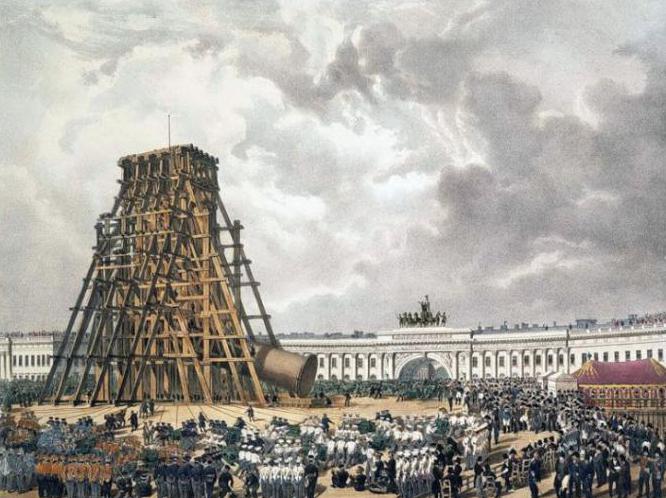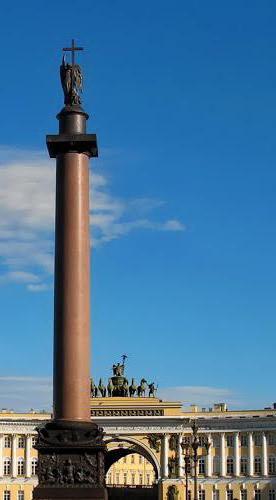The admiration of tourists is caused by many sights of St. Petersburg. The Alexander Column occupies a special place among them. Many of those who come to the Northern capital of Russia go first of all to Palace Square. It is here that the Alexander Column is located in St. Petersburg. She is one of the most famous monuments of this city. This empire-style building was erected in the center of Palace Square in 1834. The architect is O. Montferrand. The Alexander Column in St. Petersburg was built by decree of Nicholas I. It is a tribute to the victory over Napoleon Alexander I, very important for Russia and the whole world. The Alexander Column in St. Petersburg is shown below (photo taken several years ago).
The idea of Karl Rossi
This monument complements the composition dedicated to the victory in the war of 1812 of the Arch of the General Staff. Karl Rossi, a famous architect, gave the idea of building a monument. He believed that a monument should be placed in the center of Palace Square. Rossi rejected the idea of installing another statue of Peter I on horseback. He wanted to see something else.
Montferrand Initial Project
The idea that was later realized as the Alexander Column in St. Petersburg did not immediately arise. Briefly tell about the initial draft proposed to the emperor. In 1829, an officially open competition was announced. Auguste Montferrand responded to him with his project of erecting a grand granite obelisk. However, the emperor considered that the Alexander Column in St. Petersburg should look somewhat different. A brief description of the initial project can be made on the basis of its exis, which has been preserved. The architect proposed to install a granite obelisk, the height of which will be 25.6 m, on a granite basement. It was also supposed to decorate the face of this obelisk with bas-reliefs depicting the events of the war of 1812. The architect saw on a pedestal a rider on a horse, who tramples a snake with his feet. A double-headed eagle flies in front of him. The goddess of victory follows the horseman, crowning him with laurels. Two female figures are leading a horse.
The influences of previous designs and the personality of the project
The second project, which was subsequently implemented, consisted of installing a column whose height exceeds that erected in honor of the victories of Napoleon of Vendome, installed on the square of the same name. Auguste Montferrand was offered the Roman Column of Trajan as a source of inspiration. The narrow framework of this project did not allow the architect to escape from the influence of samples known throughout the world. Only a small modification of the ideas of his predecessors was the Alexander Column in St. Petersburg. Its description, however, would not be entirely accurate if we had not mentioned the originality of this monument. In it, Montferrand expressed his own personality, refusing to use additional decorations in the structure, such as bas-reliefs, spiraling around the core of the column of Trajan. The architect chose to show the beauty of polished pink granite. 25.6 m is the height of the Alexander Column in St. Petersburg. Montferrand made his monument above all existing ones. In 1829, September 24, the project was approved by the sovereign in this new form, without sculptural completion. In the period from 1829 to 1834, construction was carried out.
Stone mining for the future column
For the main part of the column (granite monolith), rock was used. Her sculptor outlined his previous trips to Finland. In the years 1830-32. The rock was mined and pretreated at the Pyaterlak quarry between Friedrichsham and Vyborg. By the method of Sukhanov, these works were carried out. V. A. Yakovlev and S. V. Kolodkin led the production. After, having examined the rock, the masons confirmed the suitability of this material, a prism was cut off from it, which significantly exceeded the future column in size. Gigantic devices were used for this: huge gates and levers in order to move a huge block from its place and then topple it onto an elastic and soft bed of fir spruce branches. Huge stones were cut down from the same rock after separation of the workpiece for the foundation of the monument. The largest of them weighed more than 400 tons.
Delivery of stone and columns to St. Petersburg
It was very difficult at that time to implement such a grandiose project as the Alexander Column in St. Petersburg. Interesting facts are associated not only with the extraction of stone, but also with its transportation. Parts of the future column were delivered to St. Petersburg by water. The barque of a special design was used for this. The monolith itself was fooled in place, after which it was prepared for transportation. Colonel Glasin, a ship engineer, dealt with transportation issues. He designed and then built a special bot called "St. Nicholas". Its carrying capacity reached 1100 tons. A special pier was built for loading operations. Loading was carried out from a wooden platform. The column was loaded on board, after which the monolith set off to Kronstadt on a barge towed by two steamboats, and then to St. Petersburg to the Palace Embankment. In 1832, on July 1, the central part of the future column arrived in St. Petersburg - an important event that marks the history of the Alexander column in St. Petersburg.
Foundation of the column

Since 1829, work began on the Palace Square on the construction of a pedestal and foundation. They were led by Montferrand, architect of the Alexander Column in St. Petersburg. First of all, we carried out geological exploration of the nearest area. The sandy continent was discovered at a depth of 5.2 m near the center of the square. The place for the column was approved in 1829. 1250 six-meter pine piles were driven under its base. Then they were cut under the spirit level. Thus, a platform was created for the foundation on which the Alexander Column in St. Petersburg was to stand. A brief description of the foundation is as follows. It consists of stone granite blocks half a meter thick. With the foundation masonry, the foundation was laid out to the horizon of the square. A bronze box with coins minted in honor of the victory in the 1812 war was laid at its center. The work was completed in 1830, in October. The artist G. Gagarin captured on his canvas how they built the Alexander Column in St. Petersburg.

Column hoisting
The new stage was the installation of a 400-ton monolith on the foundation. This monolith serves as the base of the pedestal. In those days, of course, it was not easy to install such a heavy stone on the foundation. But they coped with this task. In 1832, by July, the pedestal was completed, and the monolith of the column was on the way. Now the most difficult task was to install a column on a pedestal. The original lifting system was designed by A.A. Betancourt in December 1830. For this, scaffolding 47 meters high, 60 capstans, and also a block system were needed.

A column on an inclined plane was rolled up onto a special platform located at the foot of the forests. After that, she was wrapped in rings of ropes with blocks attached to them. At the top of the forests was another block system. A large number of ropes that encircled the stone were wound with free ends on capstans placed on the square. The sovereign, along with the entire imperial family, came to rise. In order to bring the column upright, Betancourt needed to draw strength of 400 workers and 2,000 soldiers on Palace Square to establish a monolith in 1 hour 45 minutes.
Establishment of a statue on top of a column
After installation, it only remained to fix the decor elements and bas-relief slabs on the pedestal, and also to polish the columns. In September 1830, in parallel with the construction of the column, Montferrand also worked on the statue, which was supposed to crown it. She had to be turned, according to the desire of Nicholas I, to the Winter Palace. The column in the original design was completed by a cross that was wrapped around a snake. The sculptors of the Academy of Arts, in addition, offered several options for angels with a cross. As a result, the figure made by B. I. Orlovsky was accepted for execution. Two years lasted polishing and decoration of the monument.
Grand opening of the monument
In 1834, on August 30, work on Palace Square was completed. The sovereign with the family, the diplomatic corps, representatives of the Russian army and the 100,000th Russian army attended the opening ceremony. In the Orthodox surroundings it was carried out. The opening ceremony was accompanied by a solemn service at the foot of the column. In honor of the opening of this monument, a commemorative ruble was issued with a circulation of 15,000 coins.
Monument Description

Samples of the triumphal structures of antiquity are reminiscent of the Alexander Column in St. Petersburg, a photo of which is presented in this article. This monument has amazing beauty of the silhouette, laconic form, clarity of proportions. It is the tallest in the world created from solid granite. The monument is crowned by the figure of an angel made by Boris Orlovsky. He holds a four-pointed Latin cross in his left hand and raises his right hand to the sky. The angel's head is tilted; his gaze is fixed on the earth. His figure, according to the initial draft of Montferrand, was to rest on a steel bar. However, it was later removed. When the restoration was carried out in 2002-2003, it turned out that the angel is supported by its own mass. His facial features were given a resemblance to Tsar Alexander I. An angel trampled a serpent with a cross, which symbolizes peace and peace that Russia brought to Europe by victory over Napoleon’s troops. The slenderness of the column is emphasized by the light figure of the angel, as well as the vertical cross, which continues the vertical of the monument.
Bronze fence
The Alexander Column in St. Petersburg is surrounded by a bronze fence, which was designed by O. Montferrand. Its height is about 1.5 m. It was installed in 1834, and completely all the elements - in 1836-1837. The guardhouse was built in its northeast corner. In it was a disabled person dressed in a guards uniform. He guarded day and night such an important monument as the Alexander Column in St. Petersburg, and also monitored the order in Palace Square.